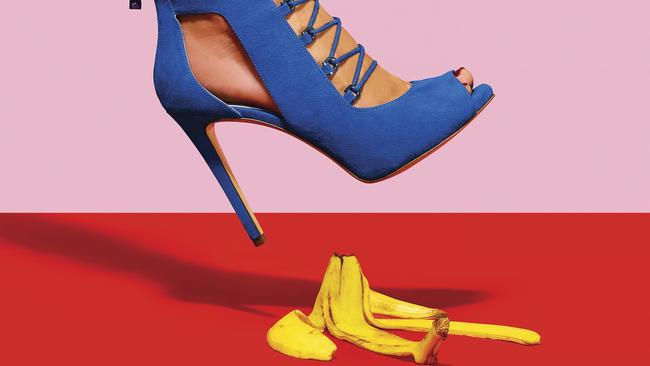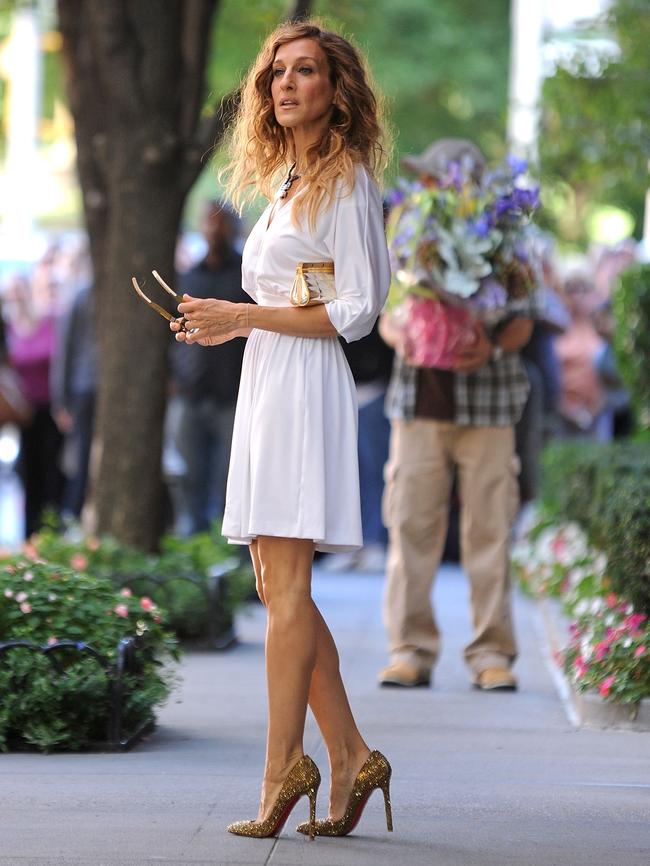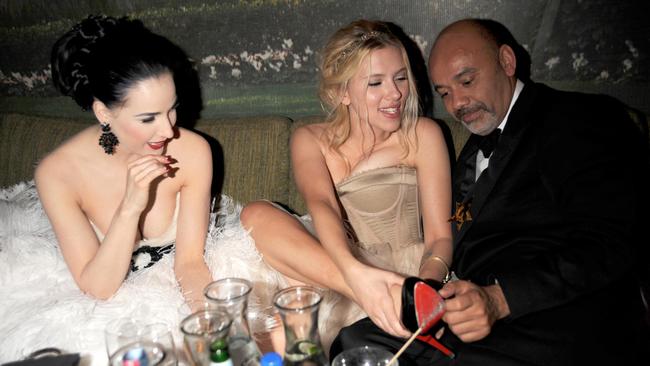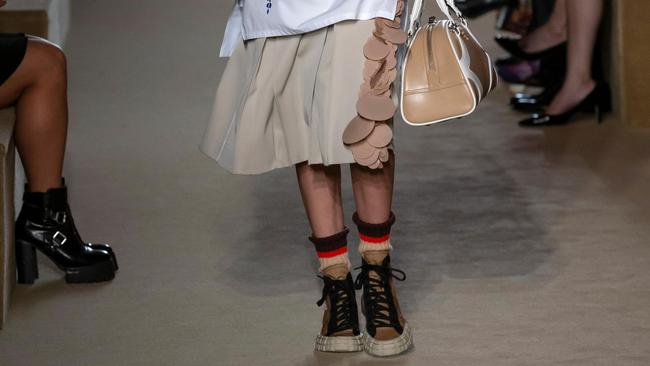Are killer heels dead?
Vale, killer heels... Now that women are used to comfort, is the stiletto finished for good?

The Sex and the City shoe-turier Christian Louboutin has built a business on being in step with trends. Baby steps, perhaps, given the tallest of his designs teeters at almost 8 inches (20.3cm), but the man who turned high heels from wardrobe staple into personality type has a good track record of knowing what it is that women most desire.
So it was surprising to hear him in Paris last month sounding so thoroughly out of synch. “I don’t want people to look at my shoes and say, ‘That looks comfortable,’” he told guests at the private view of his new retrospective. “When I design, I don’t think about comfort.”
Which is a shame, because when women shop, they tend to. Especially now we’re self-isolating, staying away from offices and cocktail parties. Now we’ve kicked our high heels off, will we ever want to put them back on again? Will this be the decade that the power heel finally dies?
For some they’re already long gone. Among Gen Z shoppers, the resurgence of Doc Martens has become a global phenomenon; the brand reported 70 per cent growth last year. The ’80s punk boot is now a fashion purchase, worn with sexy dresses and plenty of make-up, glam above the ankles and grunge below.
Retail analysts at online shopping site Lyst noted a 25 per cent year-on-year decrease in sales of heels last month, while heeled boots had dropped 40 per cent. In 2018, overall sales of heels were down 12 per cent, while trainers rose by 37 per cent. According to market researcher Mintel, fewer of us bought heels last year than in the year before, and trainers were the most popular category of women’s footwear.
Which must be a relief for models. Simply search YouTube for the montages of models falling over – many of them viewed more than a million times – for the endless variations of pitfalls and pratfalls that skyscraper heels can cause. I have been at shows where breath was collectively held for 15 minutes until the torture was over, as model after model slipped, skidded and stacked their way round as though on an ice rink, thanks to nail-like stilettos that were meant to evoke glamour.
In the most recent shows, the many models in trainers routinely lapped their unfortunate peers who had been chosen to showcase the one towering pair of heels that remained in that brand’s collection. They dawdled behind them, like traffic queuing up behind a learner driver, while the rest of us marvelled at how we used to voluntarily incapacitate ourselves.

The reason lies squarely with Sex and the City. Between 1998 and 2004, women were drip-fed a sort of heels propaganda, a Manhattan myth that encouraged us to believe that New York women tripped about in nothing less than 4in [10cm] heels at all times. The glamour of Carrie Bradshaw’s shoe cupboard versed us in high-end brands and even higher heels. We became a world of footwear fetishists, casting aside practical mid-heights (which had formed the bulk of most brands’ catalogues until then) and opting instead for ever brighter colours, more bravura and, ultimately, more height.
Forget a sturdy low block a la Queen Elizabeth II or a Bridget Jones-era kitten, heels became a test of strength in the Noughties, a night out non-negotiable. There were women who travelled to work in their trainers or tucked a pair of ballet pumps in their bags to mitigate the damage. To the pros, it was a badge of honour not to need to.

Time will tell whether stilettos come to be seen as the arsenic face powder or whalebone corsets of their day. Pick a side in the culture war and they’re either tools of female empowerment or heir to the hobbling practice of Chinese foot-binding. “Being a woman is enjoying the freedom to be feminine,” Louboutin said in his defence of heels.
True, they can be incontrovertibly glamorous, not to mention leg-lengthening and flattering, but heels are also uncomfortable, unhealthy even – and at odds with modern life. “Practical is a way of life now – you feel like an idiot if you’re running around in silly shoes,” says Ellie Pithers, digital director at British Vogue. It’s hard to come back from comfort – we’ve opened Pandora’s boxfresh Nikes, if you will.
At Kurt Geiger, trainer sales grew by 35 per cent last year and are projected to grow by 50 per cent again this season. As a proportion of all the own-brand women’s shoes it sells, trainers are up 500 per cent over the past six years. “We’ve increased our sneaker collection by a third this spring,” says the brand’s creative director, Rebecca Farrar-Hockley. “Four years ago, we had a range of heels at almost 5in [12.7cm]. Now none is higher than 3.5in [8.9cm]. The sort of high-heeled courts typically worn for work are not selling at all.”
Instead, women are choosing low, chunky blocks on ankle boots, mid-height slingbacks or the sort of trainers that barely register as sports shoes: glamorous leopard-print plimsolls, sequin-covered high-tops or opulent metallics more suited to black tie than track and field.
Other items popular during the Noughties that we have shed over the past decade include thongs and push-up bras; heels appear to be part of a pornified past that now feels strikingly out of step.

Even Anna Wintour, a stickler for heels among her staffers, has downgraded in recent years. Her preferred Manolo Blahnik Maysale pumps come with a 3in [7.6cm] heel or a 2in [5cm] one; she’s as likely as not to be in the lower version now, at 70, and her trademark tall boots all have a block heel in place of the old spindles.
Sportswear didn’t only infiltrate footwear trends; it also revolutionised wardrobes in the form of what retailers call “athleisure” – exercise garb worn beyond the gym. Gym kit and all things “wellness” became a status symbol. Leggings began to eat into the market share usually held by skinny jeans; among teenage girls, they were weekend mufti. The only shoe you could wear with them? Trainers. Insta It girls Gigi Hadid, Hailey Baldwin (now Bieber) and Kendall Jenner, with 200 million followers between them, have popularised the trainers-and-hoodie look, alongside pop stars such as Ariana Grande and Dua Lipa. Thanks to them, a generation of young women now see heels as something that their mums wear, as contorted to them as Scarlett O’Hara’s 18in [46cm] waist.
When I asked the Louboutin brand for clarification on the highest heel they’d made, I was told, “We’re not talking about tall heels at the moment.” This translates roughly from fashionspeak as, “They are dead to us.”
In fact, Louboutin’s highest ever was 2007’s Ballerina Ultima, a vertiginous pump with an 8in [20cm] spike designed in collaboration with filmmaker David Lynch and which looks about as comfortable as you might imagine – like a ballerina on blocks. It features in the Fetish room of Louboutin’s L’Exhibition[nist] retrospective in Paris, and is a stark reminder of what too much of a good thing looks like.
In 2008, I scored my first newspaper byline with a piece called “The Height of Fashion”. On the page, my cub reporter words fitted around an actual-size image of Christian Louboutin’s latest skyscraper shoe, the Lola, whose spindly gold-tipped heel stood at 5.5in (14cm). There were reports that women in LA were opting for cosmetic toe amputation to better fit their feet into them. Not long afterwards, I bought a pair of the so-called must-have Saint Laurent Tribute pumps (5in, or 13cm, with a platform of 1in – 2.5cm – and a heel surface area of less than 1in): I wore them once. I could barely stand up in them. I have those Tributes still, but these days they look like what they always were: mainstream fetish gear. In 2020, I wear trainers. I gave up wearing high heels in 2012 when I broke my leg while dancing in a pair. I caution you to do the same.
